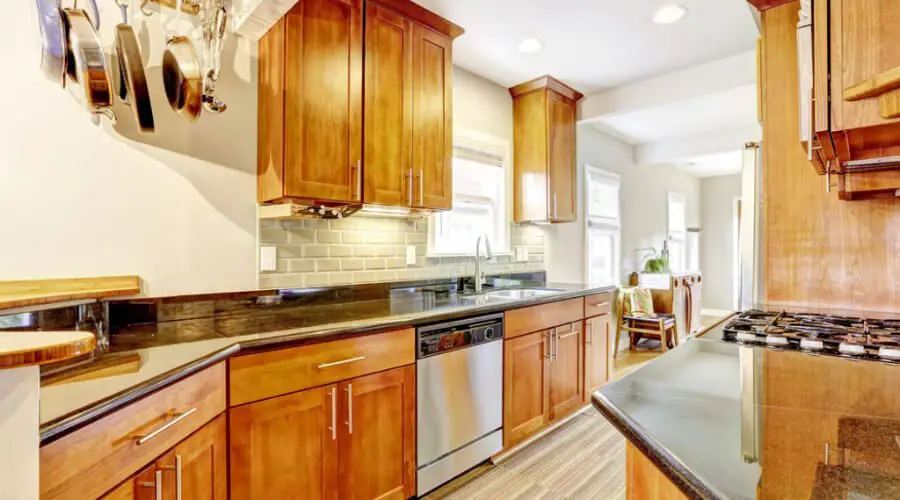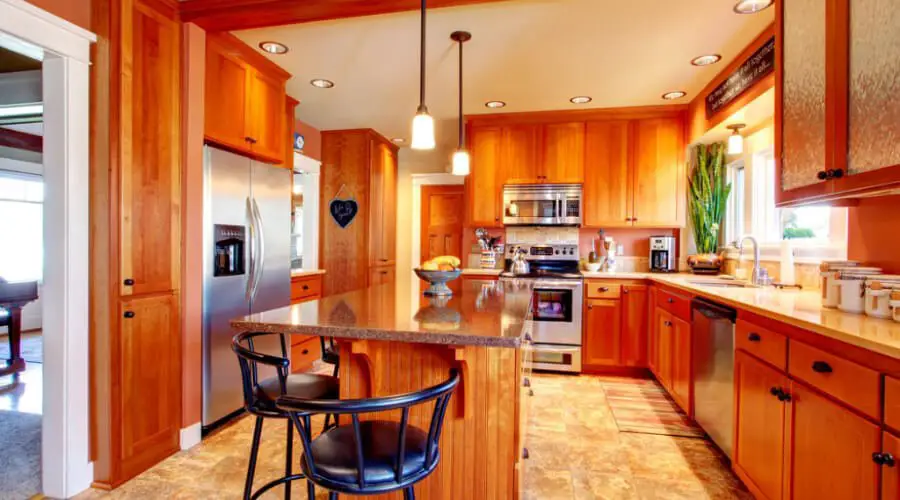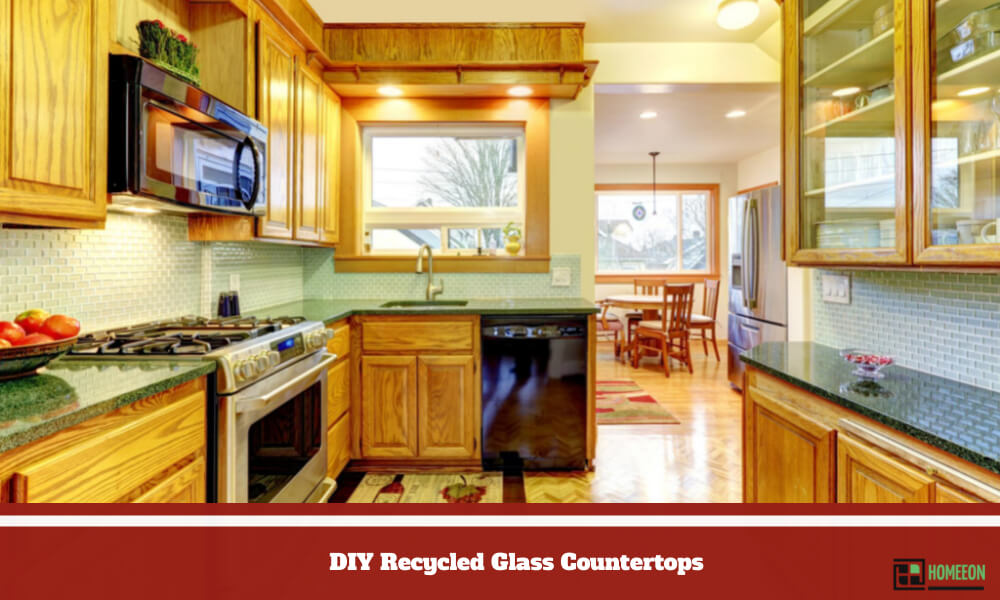Last Updated on July 30, 2023 By Emma W. Thomas
Here’s a step-by-step guide to DIY Recycled Glass Countertops:
- Gather recycled glass or other glass items
- Clean and crush glasses into small pieces
- Create the desired countertop shape with concrete or resin
- Mix glass and base with the base material
- Spread the mixture evenly and level it
- Finally, cure and seal the countertop for durability
Steps To Follow When Making Recycled Glass Countertops
Although making recycled glass countertops is not a DIY-friendly project due to the delicate nature of this material, you can still do it. Follow these simple steps;
Requirements
- Caulking gun
- 100% door & window, and 3/4 melamine baseboard
- Masking tape, adhesive, and utility knife
Step 1 – Cutting The Melamine Board
- Cut the melamine board from the base and place it on foam to form a wall. Foam form walls and liners come in heights of 2 and 2 ½ – inches, but you need to cut them to 1 inch for kitchen countertops.
- Cut the access foam starting from the top using a hand saw. (no need to cut the access foam lengthwise)
Step 2 – Attaching Form Walls To Foam The Base.
- Place some double-stick carpet tape beneath the form walls
- Press the form wall to the baseboard and make sure it is straight
Step 3 – Cutting Wall Liners
- Since CHENG Pro form liners have a width that is above 2 inches, cut them to 1 inch.
- Fill any gap in the corners with silicon, and be sure to seal the mold.
Step 4 – Sticking Wall Liners To Form Walls.
- Wall liners have a shiny surface on one side and dull on the other. Be sure to spray the shiny surface with adhesive spray and leave it to dry.
- Attach the liners to the form wall’s top
- Make sure that your recycled glass countertop is uniform and straight
- Using silicon, seal the concrete to prevent it from running on the wall liners and foam wall parts. Be sure to apply the silicone sealant laterally at the top of the form wall
Step 5 – Sealing The Form
- Using bead of silicone and seam-shaping equipment, make professional round edges.
- You may also fill the gaps between the form base and liner to make your countertop airtight. Use a 100% bead of silicone to seal the corners.
- You can use denatured alcohol to get rid of any residual silicone
Make sure that you level the form throughout the casting process. Doing this helps to ensure that the thickness is even
Step 6 – Mixing The Pigment And Liquid Modifier
- You need to wear a mask, gloves, and any other protective gear before starting this procedure.
- Shake well the liquid modifier and then pour it into a 15-gallon bucket
- Add an entire bag of Indigo pigment into the bucket containing the liquid modifier. Be sure that they blend well
Step 7 – Adding Terrazzo Mix
- Add a 1/3 bag of terrazzo mix to the blend of pigment and modifier. Mix the substances thoroughly to produce a smooth blend with no lumps
- Be sure to scrape off the mixture from the sides of the bucket and ensure you get a smooth mixture.
Step 8 – Adding The Recycled Glass Chips.
- Using a paddle mixer, mix the blue color glass aggregate with the terrazzo blend. Stir until the mixture is even and smooth
- To the mixture, add 2 to 3 cups of water to make a semi-pourable consistency.
Step 9 – Casting
- Wear heavy-duty rubber gloves when casting the recycled terrazzo blend. Doing this will protect you from injuries since crushed glass can tear other types of gloves.
- This process is similar to concrete casting. But, be careful as glass aggregate is sharp and risky to handle
Step 10- Attaching The Vibrator To The Casting Table
- You require two table vibrators on every side of the casting table
- Be sure to place the casting table in the shade. You can do it indoors
- Use long screws to join the table vibrators to a controller with variable speed
- Plugin the controller into the wall outlet and connect vibrators to the controller. You need to test if they are all operating properly
Step 11 – Pouring The Concrete
- Using a bucket, ensure that the terrazzo concrete mixture is even by shifting from tub to form.
- Spread this mixture in the corners. Ensure that it is even
Step 12 – Grinding The Concrete
- Flatten the parts of concrete from the form using grinders
- Ensure that the front and bottom edges of the concrete are straight and consistent
Step 13 – Remolding
- You can recycle the countertop before remolding
- Be careful when carrying out this procedure to prevent cracks from occurring. Support the countertop at a distance of 12-inches then remove it from the mold
Step 14 – Removing Form Walls And Polishing
- Peel off from walls and keep them aside
- Use diamond hand pads to scrub the ragged edges of concrete before flipping them over.
- Use a dry/wet polisher to polish the glass aggregate. You can use lithium densities while polishing to form a slurry.
Step 15 – Finishing
The final step is to polish the countertop to give you the appearance that you desire.
- Using a high-gloss color-enhancing sealer, seal the glass countertop. Doing this helps to produce the boldest hue possible.
- For better performance and content protection, apply two coats of Surecrete PC sealer.
What Are The Main Types Of Recycled Glass Countertops?

Recycled glass (also known as crushed glass) countertops occur in two major types, i.e., homogenous glass and terrazzo.
Terrazzo Style Countertops
Terrazzo style uses crushed glass and glass chips as a by-product. It can also use post-consumer waste such as wine and beer bottles or post-industrial waste from demolition or manufacturing plants. This design can be divided into two categories according to the binders used, i.e., resin or cement-based.
Comparison Between Resin And Cement Countertops
Cement Countertops | Resin Countertop |
They are porous and require seasonal application of sealer. | They are non-porous and do not stain. |
Acids etch them | Not etched by acids |
Prone to scratches | They are resistant to scratch. |
Can be recycled | It can be made from renewable substances like corn. |
Do not crack easily | Cracks easily |
Homogenous Glass Style
This style melts down the crushed glass products into a single mass. This substance is then customized to form solid slab glass countertops. In this type of matrix, there are no scattered glass chips. You can get various color surfaces with custom designs and textures with additional backlights to make them glow.
This style is rare and looks different from the terrazzo one.
What Are Some Advantages Of Recycled Glass Countertops?

Crushed glass countertops have various advantages, including;
They Are Eco-friendly
Using recycled glass to make countertops is environmental-friendly as these materials could otherwise end up in a landfill.
Unique Style Options
1. You can get any hue that you desire with recycled glass. It is possible to mix the pigments in any ratio when making the countertops, and this brings out any imaginable shade like when creating a paint color.
2. You can also arrange the glass chips the way you like to create unique patterns.
3. It is possible to customize a specific glass mixture and type. You can pick certain colors and combine or mix them with a matching matrix binder. Doing this will help to complement the design of your kitchen.
4. The glass allows light to penetrate through, creating a unique appeal that other materials do not give on your countertop.
Easy to clean
Recycled glass countertops are easy to clean, unlike other types. You can use a pH-neutral cleaner and hot water to get a sparkling surface. But, using soap repeatedly may end up in a dull surface that is not appealing to the eye.
What Are Some Disadvantages Of Crushed Glass Countertops?
Recycled glass countertops also have some disadvantages, which include;
Not Very Cheap
Crushed glass countertops are not the cheapest choice and are therefore not so a budget choice. They could be priced the same as their granite counterparts or even higher. But, they could be a worthy investment since they can last up to half a century.
Limited Availability
While these countertops are becoming popular, they are not readily available. You cannot just order them from your local improvement store. It is also not very easy to source recycled glass like the case is with other materials. It would take more effort to acquire the resources you need.
They Can Get Stained And Etch Marks.
Cement-based surfaces will get etch marks and stains from chemicals and acidic foods. These counters will, therefore, need sealing to protect them from such stains.
While resin-based surfaces are resistant to food stains and may not require sealing, they may be discolored by certain chemicals and cleaners. The discoloration is usually permanent, which may make them look unappealing.
Are The Recycled Glass Countertops Expensive?
The cost of recycled glass countertops ranges between $45 and $190 per square foot. But, this price may be higher depending on some factors such as additional heat and stain resistance, durability, colors, type of glass used, and patterns. The market in which they are sold, the availability of stock, and the shipping cost may also affect the price per square foot.
Conclusion
While making recycled glass countertops is not a friendly DIY project due to the risks involved, it is a worthy investment. These countertops come in different styles and types, and they can add to the aesthetic value of your home. But, it is essential to understand the whole process of making them before embarking on it.
Since crushed glass and chips are delicate to handle, ensure that you perform this task in a conducive environment such as under the shade, and use the right tools.
References:
https://www.instructables.com/Recycled-Glass-Countertop/
https://www.weekand.com/home-garden/article/make-recycled-glass-counters-18033767.php
Emma is a graduate of Domestic Science or Family and Consumer Sciences (Home Economics) from the University of Wisconsin. She has 7 years of experience Working with the strategic section of BestBuy and now writing full-time for Homeeon.
From Managing the Home, Interiors, Cleaning, and Exteriors to Gardening and everything about Making A Home Liveable – is her passion and this Homeeon is the result of this.
Emma loves decorating her home with the best stuff found online. She cares about quality over anything and writes reviews about them here in Homeeon. Get in touch with her over Pinterest.
Keep reading her blogs.

